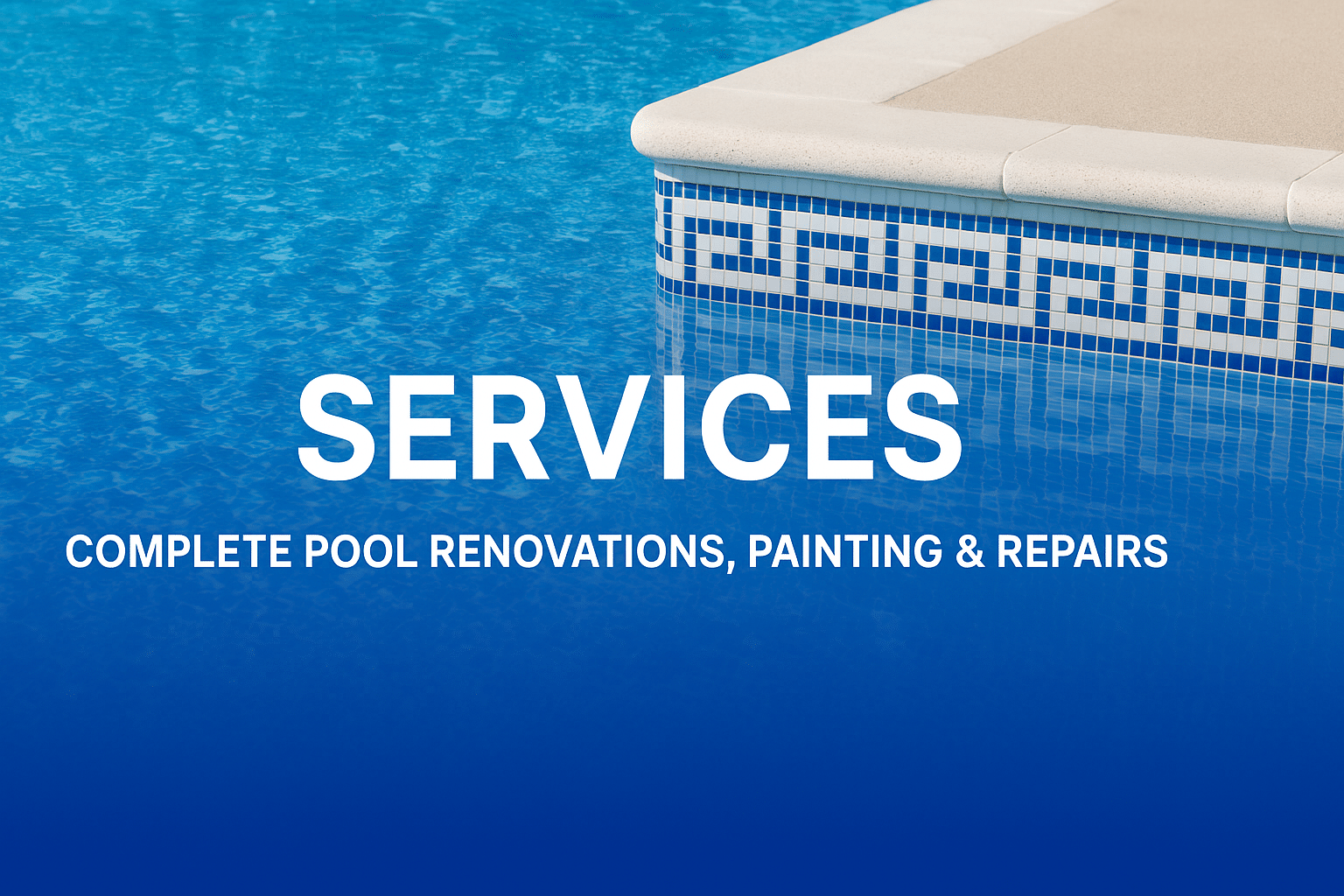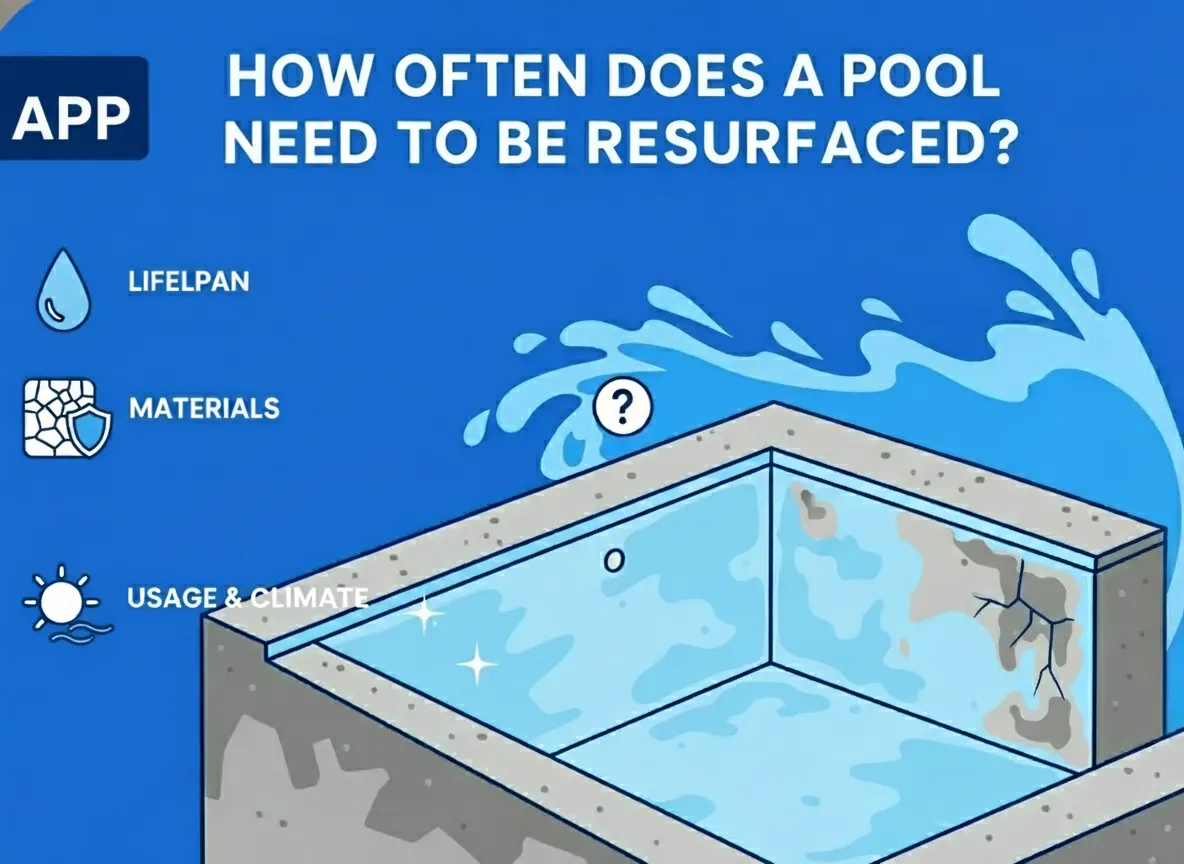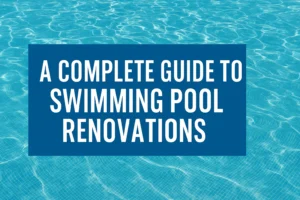If you’re a pool owner in Sydney, you’ve probably wondered: how often does my pool actually need resurfacing? It’s one of those questions that doesn’t have a simple one-size-fits-all answer, but understanding the factors involved helps you plan and budget effectively.
The honest truth? Your pool might need resurfacing anywhere from every 5 years to every 25 years, depending on what type of surface you have and how well you maintain it. Let me break down exactly what you need to know.
Quick Answer: Pool Resurfacing Frequency by Surface Type
Here’s the straightforward answer most Sydney pool owners are looking for:
| Pool Surface Type | Average Resurfacing Frequency | Lifespan Range |
|---|---|---|
| Paint (Epoxy) | 7-10 years | 5-12 years |
| Paint (Acrylic) | 5-7 years | 3-9 years |
| Paint (Chlorinated Rubber) | 2-4 years | 2-5 years |
| Standard Plaster | 10-15 years | 7-20 years |
| Quartz Plaster | 12-18 years | 10-20 years |
| Pebblecrete | 15-20 years | 12-25 years |
| Aggregate Finishes | 12-18 years | 10-20 years |
| Fibreglass | 15-25 years | 15-30+ years |
| Tiles | 20-25 years | 15-30+ years |
“The biggest mistake pool owners make is waiting until their surface is completely failing before considering resurfacing,” explains experienced pool repair and maintenance services. “Catching problems early and scheduling preventive resurfacing actually costs less long-term than emergency repairs after major damage occurs.”

Understanding Why Pools Need Resurfacing
Before diving into specific timeframes, let’s talk about why resurfacing becomes necessary in the first place.
Your pool surface battles constant challenges: chemicals, UV radiation, temperature fluctuations, physical wear from cleaning, and Sydney’s harsh climate conditions. Over time, these factors break down even the most durable surfaces.
Signs Your Pool Needs Resurfacing Soon
Watch for these warning signals that indicate your pool’s surface is approaching the end of its life:
Surface Roughness: Run your hand along the pool wall. If it feels rough or scratchy, the surface is deteriorating. This happens when the top protective layer wears away, exposing the aggregate underneath.
Staining That Won’t Clean: Persistent stains that survive thorough cleaning often indicate the surface has become porous and is absorbing materials rather than repelling them.
Visible Cracks: Small hairline cracks might not seem urgent, but they allow water to seep behind the surface, causing bigger problems. Professional pool crack repair in Sydney can sometimes extend your surface’s life if caught early.
Chalking or Fading: For painted pools, significant chalking (that powdery residue on your hands) or dramatic fading signals the protective coating is breaking down.
Frequent Leaks: If you’re constantly topping up water and suspect leaks, pool leak detection services can identify whether surface deterioration is the culprit.
Painted Pools: Most Frequent Resurfacing Needs
If you have a painted pool, you’ll need to think about resurfacing more frequently than other surface types. But that doesn’t make painting a bad choice, it just requires different planning.
Epoxy Paint: The Long-Lasting Option
Quality epoxy paint represents the gold standard for pool painting. In Sydney conditions with proper maintenance, epoxy typically delivers 7 to 10 years of service.
“We consistently see well-maintained epoxy-painted pools in Northern Sydney and Eastern Sydney reaching that 10-year mark,” notes professional pool painting services. “The key is balanced water chemistry and addressing small issues promptly.”
Acrylic and Chlorinated Rubber: Budget Options
Acrylic paint offers a middle ground, lasting 5 to 7 years, while chlorinated rubber provides the shortest lifespan at just 2 to 4 years. These options cost less upfront but require more frequent reapplication.
For detailed cost comparisons, explore comprehensive guides on pool resurfacing cost factors.
Plaster Pools: The Traditional Choice
Standard white plaster remains popular despite requiring resurfacing every 10 to 15 years. The actual timeline varies dramatically based on several factors:
Water Chemistry: This is the number one factor affecting plaster longevity. Unbalanced pH levels, particularly acidic conditions, eat away at plaster surprisingly quickly. Pools with consistently balanced chemistry can reach 20 years, while those with chemical imbalances might need resurfacing in just 7 years.
Usage Intensity: A heavily used family pool experiences more wear than one used occasionally. High traffic accelerates surface deterioration.
Climate Exposure: Sydney’s intense UV radiation affects different suburbs differently. Pools in Western Sydney with full sun exposure typically need resurfacing sooner than shaded pools in Northern Sydney.
Enhanced Plaster Options
Quartz plaster, which includes quartz crystals mixed into the plaster, lasts longer than standard plaster (12 to 18 years) and provides a more durable, smoother finish. The additional cost usually pays off through extended life and reduced maintenance.

Premium Surfaces: Longer Intervals Between Resurfacing
If you’re tired of frequent resurfacing, premium options offer significantly longer lifespans.
Pebblecrete: The Durable Natural Look
Pebblecrete resurfacing typically lasts 15 to 20 years and sometimes beyond. The exposed pebble aggregate creates an incredibly durable surface that withstands wear better than plaster or paint.
Pebblecrete pools in areas like Castle Hill, Baulkham Hills, and throughout The Hills district consistently demonstrate this longevity.
Fibreglass: Maximum Longevity
Fibreglass pool resurfacing offers the longest lifespan of any resurfacing option, typically 15 to 25 years and sometimes reaching 30 years with proper care.
“Fibreglass eliminates many of the chemical balance concerns that plague plaster pools,” explains pool repair and maintenance services. “The surface is non-porous, so it doesn’t absorb chemicals or develop algae issues as readily.”
Tile: The Premium Choice
While less common due to cost, fully tiled pools can last 20 to 25 years or more. Most pool owners use tiles strategically, like waterline pool tiles that combine durability with aesthetic appeal.
Factors That Affect Resurfacing Frequency
Beyond surface type, several variables dramatically impact how often your pool needs resurfacing:
Water Chemistry Management
I can’t emphasize this enough: proper water chemistry is the single biggest factor determining your surface’s lifespan. Test weekly and maintain proper pH (7.2-7.6), alkalinity (80-120 ppm), and appropriate sanitizer levels.
Professional pool resurfacing maintenance in Sydney services can help establish a maintenance schedule that protects your investment.
Regular Cleaning Practices
How you clean matters. Abrasive brushes damage surfaces over time. Use appropriate tools for your surface type and avoid harsh cleaning chemicals that accelerate deterioration.
Climate and Location
Sydney’s diverse microclimates affect pool surfaces differently. Coastal areas like Bondi, Coogee, Cronulla, and Manly face salt air exposure that can accelerate wear.
Western suburbs like Penrith, Blacktown, and Parramatta experience more intense heat, affecting surface deterioration rates.
Quality of Previous Work
The quality of your last resurfacing job significantly impacts the next one’s timing. Professional installation with proper surface preparation lasts substantially longer than rushed or DIY work.
Planning Your Pool Resurfacing Timeline
Rather than waiting for complete surface failure, smart pool owners plan proactively. Here’s how to approach resurfacing timing:
Schedule Regular Inspections
Annual pool inspections help catch problems early. Professional eyes spot issues you might miss, like early-stage delamination or problematic crack patterns.
Budget Ahead
Knowing your surface type’s expected lifespan lets you budget accordingly. If you have 10-year epoxy paint applied 7 years ago, start setting aside money now rather than scrambling when it fails.
Consider Full Renovations
Sometimes resurfacing coincides perfectly with other upgrades. If your pool needs resurfacing and you’ve been wanting to update pool coping, pool paving, or concrete pool surrounds, combining projects often proves more cost-effective.
Explore complete swimming pool renovations in Sydney to see how bundling services saves money.
Extending Time Between Resurfacing
While you can’t avoid resurfacing indefinitely, smart practices extend your surface’s life significantly:
Maintain Perfect Water Balance
Test weekly and adjust immediately when readings fall outside ideal ranges. This single habit can add 2 to 5 years to any surface type.
Address Problems Immediately
Small crack? Fix it now through pool crack repair before it becomes a major issue. Strange stain? Investigate immediately rather than ignoring it.
Use Appropriate Cleaning Methods
Match your cleaning tools and chemicals to your surface type. What works for pebblecrete might damage paint or plaster.
Minimize Chemical Shock
Avoid dumping large amounts of chemicals in one spot. Distribute them properly to prevent localized surface damage.
Current Trends in Pool Resurfacing
If you’re approaching resurfacing time, consider current design trends. Modern pool colour trends in Sydney lean toward sophisticated greys, deep blues, and dramatic blacks that transform pool aesthetics.
Additionally, many Sydney homeowners are choosing longer-lasting surfaces during resurfacing to reduce maintenance frequency. The upfront cost difference between 7-year paint and 20-year pebblecrete often justifies itself through reduced lifetime resurfacing costs.
Geographic Considerations Across Sydney
Resurfacing needs vary across Sydney’s regions due to different environmental conditions:
Southern Sydney areas like Sutherland, Miranda, Caringbah, and Menai often see moderate wear patterns.
Hills District locations including Kellyville, Rouse Hill, Bella Vista, and Dural experience varied conditions based on exposure.
Local pool repair and maintenance services understand these regional differences and can provide location-specific guidance.
Frequently Asked Questions About Pool Resurfacing Frequency
Q1. Can I extend my pool's surface life beyond the typical timeframe, or is resurfacing inevitable?
However, there's a point of diminishing returns where surface deterioration accelerates regardless of maintenance. Watch for the warning signs mentioned earlier, as continuing to use a failing surface can damage the underlying structure, making eventual resurfacing more expensive.
Q2. Does saltwater versus chlorine affect how often I need to resurface my pool?
The key is informing your pool repair and maintenance services that you have saltwater so they recommend appropriate materials. Many Sydney pool owners with saltwater systems still achieve excellent longevity by choosing the right surface and maintaining proper water balance.
Q3. Is it better to resurface proactively or wait until I see obvious problems?
Schedule a professional pool inspection when you approach your surface's expected lifespan. They'll assess actual condition and advise whether you can safely wait another season or should resurface soon. This approach balances maximizing your current surface's life while preventing the structural damage that occurs when surfaces fail completely.
Making Informed Resurfacing Decisions
Understanding how often pools need resurfacing helps you plan maintenance budgets and avoid surprises. Whether you have a painted pool requiring attention every 7 years or pebblecrete that lasts 20 years, knowing what to expect puts you in control.
The most important takeaway? Don’t wait for complete failure. Proactive resurfacing based on surface condition rather than arbitrary timelines delivers the best long-term value.
Ready to Assess Your Pool’s Resurfacing Needs?
Wondering whether your pool needs resurfacing now or can wait another season? Professional assessment takes the guesswork out of this important decision.
Schedule your free pool surface assessment today and get expert guidance on your pool’s condition and optimal resurfacing timeline.
Our experienced pool repair and maintenance services evaluate your specific surface type, current condition, and maintenance history to provide honest recommendations. We serve pool owners throughout Sydney’s regions and pride ourselves on transparent advice that prioritizes your long-term interests.
Contact us now to discuss your pool resurfacing needs with Sydney’s trusted professionals.
Whether you need pool painting, pebblecrete resurfacing, fibreglass resurfacing, or complete swimming pool renovations, we provide comprehensive pool resurfacing maintenance in Sydney that protects your investment for years to come.
Explore Our Other Services
- All Posts
- Blog

Pools Transformed. Families Happy. Results That Last. Areas We Service In Sydney From the North Shore to the Shire, we...

Pools Transformed. Families Happy. Results That Last. ADVANCE POOL PAINTING IN THE HILLS Families across The Hills trust our licensed...

Pools Transformed. Families Happy. Results That Last. ADVANCE POOL PAINTING IN SOUTHERN SYDNEY We plan around local weather, protect paving...





